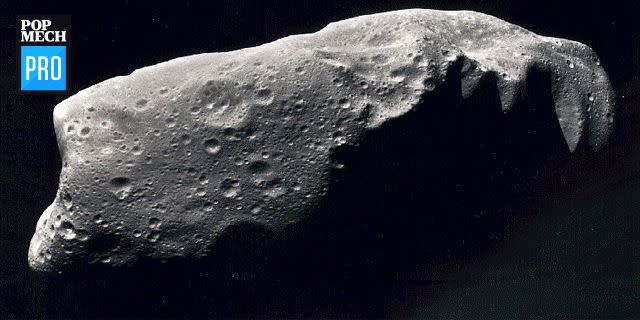How a City-Killing Asteroid Got So Uncomfortably Close to Earth

On July 25, an asteroid measuring somewhere between 87 and 427 feet wide got unusually close to Earth. No scientists had even detected the asteroid until a few hours before it passed by the planet. While never a true threat, the rock known as Asteroid 2019 OK is still raising questions about Earth's readiness for a space-born natural disaster.
This is the video of the close encounter of Asteroid 2019 OK we have been Twitting all day with the Earth: https://t.co/bjT7uhQJuO pic.twitter.com/3e4UyPcdPl
— ASAS-SN (@SuperASASSN) July 25, 2019
It might be interesting to compare how a "normal" asteroid looks like in our data, vs. 2019 OK. On the right, you have our first detection of 2019 OK - the black dot (extra light) is moving significantly between the exposures; on the right, a normal asteroid, staying still pic.twitter.com/PcEnZyQecf
— ASAS-SN (@SuperASASSN) July 27, 2019
Scientists spotted OK 2019 just a few days before its close encounter with Earth. The Brazilian SONEAR survey and American teams made the discovery separately. But no group was aware of the asteroid's route, and how close it had gotten to Earth, until shortly before the event took place. OK 2019's path took it within 45,360 miles of Earth, roughly one-fifth of the distance between here and the moon.
"It’s impressively close," said Michael Brown, of Monash University’s school of physics and astronomy, to the Sydney Morning Herald. "I don’t think it’s quite sunk in yet. It’s a pretty big deal. [If it hits Earth], it makes the bang of a very large nuclear weapon—a very large one."
Scientists around the planet were caught off guard by OK 2019. Speaking to the Washington Post, Alan Duffy, the lead scientist at the Royal Institution of Australia, called the asteroid "a true shock.”
Small objects fall from space into Earth's atmosphere all the time without much fanfare or drama. Just last month, NASA's Center for Near Earth Object Studies tracked a tiny, harmless object known as MO 2019, only 16 feet in diameter as it disintegrated.
"Asteroids this size are far smaller than what we're tasked to track," Davide Farnocchia, a scientist at the Center for Near Earth Object Studies, said in a press statement at the time. "They're so small, they would not survive passing through our atmosphere to cause damage to Earth's surface. But this event shows how capable our search programs are, even for objects of such small sizes."
But if June's asteroids showed the strengths of the current planetary defense systems, then July's showed its weaknesses.
There's the size, first of all. While OK 2019 was significantly larger than MO 2019, it's still relatively small in the void of space.
“Nothing this size is easy to detect,” Duffy told the Post. "You’re really relying on reflected sunlight, and even at closest approach it was barely visible with a pair of binoculars.”
There's also its orbit, which Brown calls "eccentric." OK 2019's orbit takes it “from beyond Mars to within the orbit of Venus,” and its time near Earth is brief and hurried. When it was closest to Earth, OK 2019 was flying through space at nearly 54,000 mph.
“It’s faint for a long time,” Brown told the Post. “With a week or two to go, it’s getting bright enough to detect, but someone needs to look in the right spot. Once it’s finally recognized, then things happen quickly, but this thing’s approaching quickly so we only sort of knew about it very soon before the flyby.”
This isn't the first time an asteroid has gone undetected. Earlier this year, it was announced that in late 2018, a space rock had exploded above the Earth's surface with an impact energy of 173 kilotons. Exploding above the remote Kamchatka Peninsula, it took NASA months to detect.
Source: Washington Post
You Might Also Like

